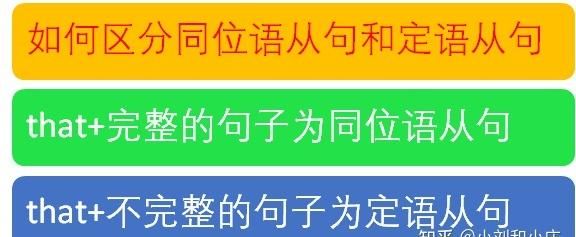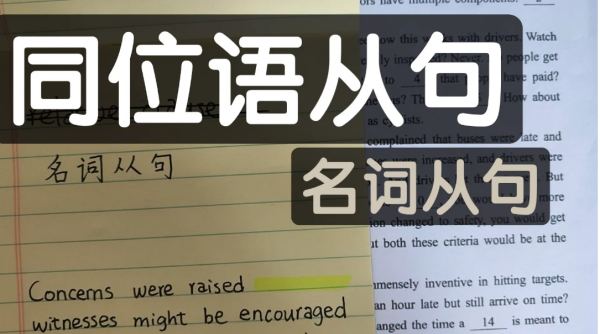本文目录
同位语从句例句 有什么例句和用法怎么写
同位语从句即重复说明同一个称谓或事件的从句。下面我整理了例句等相关内容,来看一下!
同位语从句例句五句
1、She hasn't made the decision whether she should give up。 她还没决定她是否应当放下。
2、I have no idea what has happened to him。 我不明白他发生了什么事。
3、There was no doubt that he is honest man。 毫无疑问他是诚实的人。
4、You have no idea how worried I was。 你不明白我当时有多担忧。
5、I have no idea why he resigned。 我不明白他为何辞职。
同位语从句用法
同位语部分是个句子,就是同位语从句,这种用法比较"固定"
一、在复合句中用作同位语的从句叫同位语从句。它一般跟在某些名词后面,用以说明该名词表示的具体内容。
二、可以跟同位语从句的名词通常有news,idea,fact,promise,question,doubt,thought,hope,message,suggestion,word(消息),possibility,decision等(一般的“抽象”名词都可用)。
三、英语中引导同位语从句的词通常有连词that,whether,连接代词what,who。连接副词how,when,where等。(注:if不能引导同位语从句。)
四、有时同位语从句可以不紧跟在说明的名词后面,这是因为英语中的尾重原则(即不允许“头重脚轻”的现象存在)

简单同位语例句100句
同位语从句
如果一个句子去掉其中的关系代词,这个句子是完整的2个单独的句子,这样的句子就是同位语从句
如果去掉关系代词,不是两个完整的句子,那这样的句子是宾语从句
There is a little hope that she will recover.
在fact,idea,news,word,information,thought, believe等词后面的名词性从句通常都是同位语从句. that不做成分但关系代词不可以省略.
No one could account for for the fact that one of the boxes was extremely heavy.
The fact that his proposal make sense should recognized.
We must face the fact that we might lose our deposit./money
The idea that number “13” brings bad luck seems to be quite absurd.

同位语从句例句
that引导同位语从句。
1.I had no idea that you were here。我不知道你在这里 。
2.He always works hard in spite of the fact that he is not in good health。尽管他身体不好,但他总是努力工作。

3.He grabbed his suitcase and gave the impression he was boarding the Tokyo plane。他拿起了手提箱,给人的印象是他要登上飞往东京的飞机了。
whether引导引导同位语从句。
1.There is some doubt whether he will come.
他是否会来还不一定。
2.he question whether it is right or wrong depends on the result.
这个是对还是错要看结果。
3.He must answer the question whether he agrees to it or not.
他必须回答他是否同意这样一个问题。

连接代词what,who,whom,whose,引导同位语从句
1.I have no idea what size shoes she wears.
我不知道她穿几号的鞋。(what作定语)
2.The question who will take his place is still not clear.
谁将接替他的位置这个问题还不清楚(who作主语)
连接副词when,where,how,why,引导同位语从句
1.He had no idea why she left. 他不知道她为什么离开。
2.The question where we shall have a meeting hasn't decided. 我们到什么地方去开会,这个问题没有决定。
逗号后的同位语从句怎么能快速辨别出是同位语从句
要判断同位语从句,需要知道它的重要特征
跟在某些名词后面,用以说明该名词所表示的具体内容;
是对意思表述上的模糊概念进行的具体解释,因此从句前的先行名词往往是抽象名词,如news,idea,fact,promise,question,doubt,thought,hope,message,suggestion,possibility, decision 等;
同宾语从句一样,属于名词性从句,是由 that、whether 以及连接代词(what,who)和连接副词(when,where,why,how)引导;
that 引导的同位语从句,连词 that 只是起连接,在从句中不充当成分。
除非出现在一个较长的句子,同位语从句很少用逗号分隔。
例如
The thought came to him (that maybe the enemy had fled the city).他突然想起敌人可能已经逃出城了。【对抽象名词 thought 的具体说明】
He must answer the question (whether he agrees with it or not). 他必须回答他是否同意这样一个问题。【对抽象名词question 的具体说明】
I have no idea (what size shoes she wears).我不知道她穿几号的鞋。【对抽象名词idea 的具体说明】
The question (who will take his place is still not clear). 【对抽象名词question 的具体说明】
We haven’t yet settled the question (where we are going to spend our summer vacation). 到哪儿去度暑假,这个问题我们还没有决定。【对抽象名词question 的具体说明】

以上就是关于同位语从句经典例句带逗号 ,同位语从句例句 有什么例句和用法怎么写的全部内容,以及同位语从句经典例句带逗号 的相关内容,希望能够帮到您。

